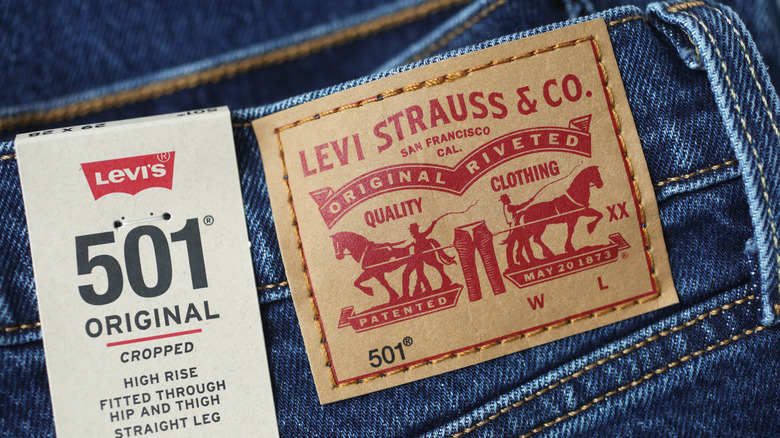Levi's 501 Is The Most Iconic Blue Jean In Fashion History - Here's Why
No matter one's personal preference or sartorial style, a pair of well-fitted blue jeans is a wardrobe staple for everyone (though in case you think you own too many of them, here's a look at how many pairs you actually need). While jean styles abound, it's safe to say that the single-most popular blue jean of the highest quality is the iconic Levi's 501.
Wondering why a humble pair of jeans has been accorded the status of being a fashion icon of note? There are many reasons for it, starting with the fact that on May 20 of this year, it celebrated 150 years since receiving a patent for its design — that's more than most items of clothing can lay claim to! And not only that: Levi's 501s were also named the "Fashion Item of the 20th Century" by TIME magazine in 1999.
Levi's 501s have an interesting history. The denim look was a true fashion disruptor when it first emerged on the scene, and over the last century and a half, it has been responsible for inspiring a number of other jean styles that based themselves on the cut and fit of the 501. As if that weren't enough, this style continues to grow in popularity every year. A look at its vibrant and long history tells us why this is the most iconic blue jean in fashion history.
The story behind the Levi's 501 jean
The idea for this particular pair of jeans arose in 1873 when Jacob Davis, a tailor from Reno, Nevada, was tasked by a client to create a hardy pair of pants to withstand the rough and tumble of a workman's life. Tracey Panek, the in-house historian at Levi's, recounts the now-legendary story to Fashionista: "He was living in Reno, close to Virginia City, where the Comstock Lode had been discovered, and that meant that there were lots of people moving to that area for work, who needed tough pants. The story goes that Davis had been asked by a woman whose husband needed some tough work pants to create a pair that could fit and not tear. He'd been working on a horse blanket using metal to attach it to a saddle, and he had the idea: What if I take a little bit of the metal and add it to the pockets?"
These experimental new pants — initially made with two different materials, denim and duck cloth – became an instant hit. "He couldn't keep up with the demand. That's when he eventually wrote a letter to his fabric supplier," adds Panek.
The fabric supplier in question was Levi Strauss & Co., a company that was already well-established in the American West. Intrigued by this new invention, Strauss offered an invitation to Davis to apply for a joint patent before the jeans officially went into production. The rest, as they say, is history.
The specialty of the design
As they were designed to be a workhorse item, Levi's 501s were initially referred to as "waist overalls". They were a comfortably generous pant made with a straight leg that was popular per the style of the day, and were meant to be worn over the regular clothing of the workmen. Stylistically, a single back pocket was added as well as a cinch to the waist. A button-up fly and a back cinch for people to hook suspenders into were other features seen on the original pair. There were also rivets, a noteworthy arched stitching on the back pocket, as well as a pocket to keep a watch.
"It was a protective outer garment, and it was originally intended for blue-collar workers who needed tough work products," explains Panek when speaking about the specialty of the design to Refinery29.
Interestingly, though production started way back in 1873, it wasn't until 1890 that this iconic blue jean got its name, "501," which would distinguish it from others on the market. In later years, the design changed, but the Levi's 501 jean remains largely the same as it was on the day it was made.
Later changes to the design
The history of the Levi's 501 jean is also linked with the social history of the United States and the world. As the jeans' design adapted through time, some of its noteworthy changes were based on customer feedback, while others were driven by external circumstances.
Two back pockets instead of one were introduced in 1901 and by 1922 belt loops were added to the jeans, with suspender buttons finally being done away with in 1937. Another iconic part of the design of the 501, the tiny red threaded loop with the name "Levi's" stitched onto it, was added to the back pocket in the year 1936 as a recognizable logo. The rivets on the back pockets were covered in 1937 after customers complained that the exposed rivets would scratch the furniture they came in contact with.
When jeans became a popular item to wear amongst women exploring life on ranches, Levi's even released Lady Levi's versions — the 401 and the 701 – largely similar in design to the 501. These designs were later incorporated under the 501 umbrella.
Big changes during World War II
While the iconic jeans style had already seen its fair share of changes, it wasn't until World War II that it underwent the most significant alterations in its design. This was largely because of the wartime material rationing that the government had imposed on all manufacturers.
For Levi's, this translated to removing the metal rivets from certain places in the jeans. This included the crotch area and around the watch pocket. Buttons branded with the Levi's name were also replaced with plain ones. Similarly, the back cinch was removed to save fabric, and the back pocket was stitched in the shape of the familiar diamond.
Another major social change around this time was the fact that more and more women began working in factories, replacing their menfolk who were fighting on the front. They also needed hardy workwear and took to Levi's 501 as a tailor-made solution.
Interestingly, this was also the time that Levi's 501 was introduced to the rest of the world. As Panek tells Fashionista, it was, "The first time the 501 goes abroad on the folks that are wearing it, on the GIs heading to Europe and Asia wearing the 501. It's also the time when we start selling them on military bases."
How Levi's 501s became a pop culture icon
By the time the Second World War ended, Levi's 501s were firmly established as a beloved item of clothing. Simultaneously, its use in mainstream media and by celebrities changed its public perception, and it gradually began to be considered a noteworthy fashion item.
Its first appearance on the big screen was when actor John Wayne wore a pair in his 1939 film "Stagecoach." By the 1960s, even Marilyn Monroe had donned her very own pair in films like "The Misfits," catapulting the Levi's 501 to a much higher pedestal than it had previously enjoyed. The style even caught the imagination of the younger generation, who began viewing it as a symbol of creativity and an embodiment of rebel culture. Over time, and to save money, Levi's 501s began to be upcycled, with people painting or patching over their pre-loved pairs to give them a unique and lived-in look. They even inspired the bell-bottom movement of the '70s when designer Peggy Caserta began styling flared jeans by cutting the side hem of her Levi's 501s.
This iconic 150-year journey of the Levi's 501 blue jean was celebrated by the company with an installation at their San Francisco center. On the occasion, the company also released a limited-edition collection of the jeans with Levi's name and logo appearing in six different languages including Hindi, Japanese, Spanish, French, Korean, and simplified Chinese.





